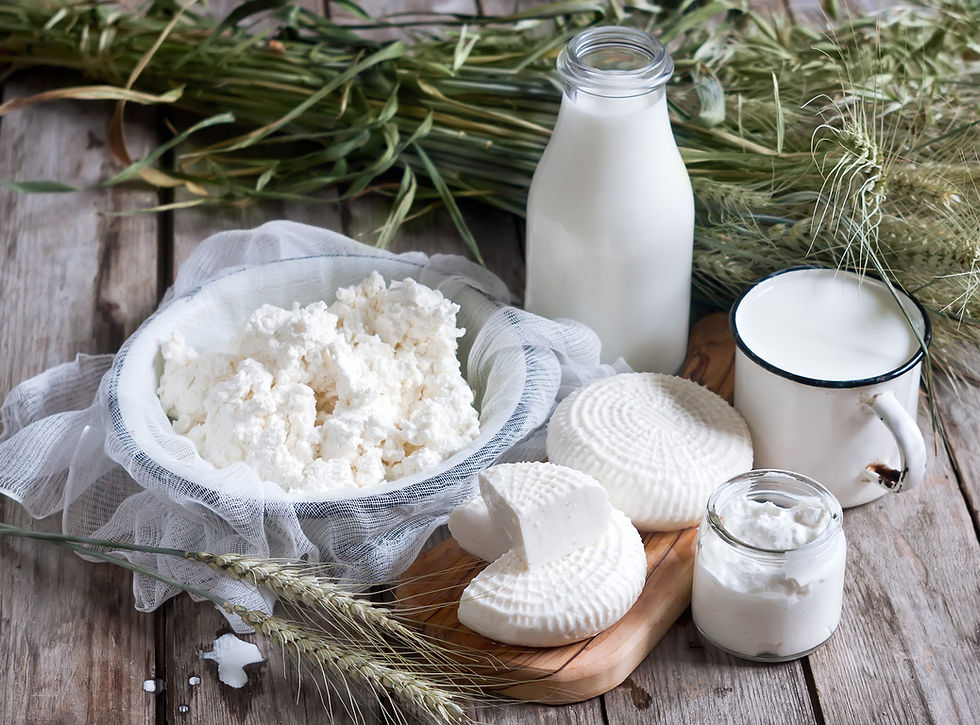Lactase: Nutrition & the Milk Sugar Enzyme
- Sylvia Rose

- Jan 15
- 5 min read
Updated: Jan 16
Lactase is an enzyme important to breaking down lactose, a sugar found in milk and dairy products, into digestible elements. Lactase is important to human health and nutrition.

It's a type of enzyme known as a glycoside hydrolase, produced primarily in the small intestine of mammals, including humans. Lactase metabolizes the sugar lactose, which is reduced to simpler sugars glucose and galactose.
Also called milk sugar, lactose is found in regular, powdered or condensed milk. It's present in butter, whey, yogurt, cheese, ice cream and other dairy foods.

Without lactase, the bodies of people, beasts and yeasts have problems digesting lactose. Creation of some dairy foods reduces amount of lactose, making nutrients of cheese and yogurt available to the consuming body.
Lactose intolerance is described by ancient Greek physician Hippocrates in the 5th century BCE. In 1906, R.H. Pimmer is the first scientist to discover the lactase enzyme in intestines of infant dogs, pigs, and rats. He also finds the enzyme is decreased in the adult intestine of these animals.

A Word About Enzymes: The Body's Catalysts
Enzymes are proteins and biological catalysts. They speed up chemical reactions in living organisms without being consumed. These microscopic tools are found in all creatures great and small.
Enzymes make life's chemical processes happen at rapid rates as they can lower activation energy needed. In humans, enzymes power many functions including digestion, repairing DNA and muscle contraction.

Emergence of Lactase
Lactase in people is rooted in evolution. Early humans consume meat and plant-based diets without dairy. With Neolithic domestication of animals, some populations begin to drink milk.
Soon after, historically speaking, a genetic mutation arises, allowing some adults to continue producing lactase beyond infancy. Lactase persistence is most common in populations with a long history of dairy consumption.
This phenomenon varies dramatically in humans. It's found in about 90% of northern Europeans compared to 20% of East Asians.

In history the ability to digest lactose influences early population survival. Dairy consumers enjoy advantages such as better nutrition and easy food availability. This evolution promotes human growth and expansion.
Lactase production peaks at birth in full-term infants and starts to decline around age three. At this point the small intestines produce less lactase, causing most animals to naturally reduce lactose intake.

Lactase & Dairy Digestion
The main task of lactase is digestion of lactose. Lactose is a disaccharide, meaning it's comprised of two simpler sugar molecules. Lactase acts on lactose by cleaving its glycosidic bond.
When lactose is ingested, lactase binds to it, using biochemical reactions to release glucose and galactose. These sugars are absorbed into the bloodstream for energy.

Lactase is primarily produced by the cells lining the small intestine. This is where most human food is broken down and absorbed. Without lactase, lactose can't be effectively reduced to sugars.
Unmetabolized lactose travels into the large intestine where bacteria are alerted to the intruder. Bacterial sugar battles cause gas, diarrhea, nausea and digestive discomfort.

Lactase vs. Lactic Acid
Lactase and lactic acid are not the same thing.
Lactase is an enzyme which breaks lactose into glucose and galactose.
Lactic acid is a byproduct of fermentation, a process also used by muscle cells during intense exercise, when oxygen levels can't keep up with demand.
While lactic acid contains the root "lact-," it's not made by lactase and doesn't come from lactose. Lactic acid is also present in many fruits and vegetables and can be eaten by those with dairy intolerance.
Lactic acid is so named because it's first isolated from milk. It's discovered by Swedish chemist Carl Wilhelm Scheele in 1780.

Science and Applications
In contemporary settings, lactase and its derivatives have practical applications. The food industry adds lactase to dairy products to create lactose-free options.
The market for lactose-free products is projected to reach $28 billion this year (2025). It's geared toward consumers who want to manage lactose intolerance without sacrificing flavor.
It's commercially produced for use in dairy products, to metabolize lactose for lactose-intolerant patients. In the food industry, lactase is also used to prevent lactose from crystallizing in products like ice cream.

The Case of Yeast
Lactase is harvested from microorganisms like yeasts and other fungi. Like humans, most yeasts are lactose-intolerant. Only a few species, like Kluyveromyces marxianus, have the ability to break down lactose.
Yeasts are unicellular and especially intriguing in this regard. Their cell structure resembles that of human cells, with complex processes and natural adaptations.

Points of Interest
The majority of the world's population, over 65%, is lactose intolerant. Lactase persistence is the exception, not the rule.
Different people have varying degrees of lactose intolerance. Some can tolerate small amounts of dairy, while others experience symptoms even from tiny exposures.

Enzymes are highly affected by heat. If heated too much, they lose their shape and ability to function. Enzymes are part of nearly every biological process. from creating DNA and hormones to detoxifying substances.
Dairy Alternatives
The rise of plant-based diets has increased interest in lactose-free products. While lactase aids those who are lactose intolerant, many consumers are now turning to alternative milk sources like almond, soy, and oat milk, which have seen significant market growth.
Making soy milk is a simple process. Soy milk is created by blending soaked soybeans in water and straining the solids.

Non-Fiction Books:
Fiction Books:
READ: Lora Ley Adventures - Germanic Mythology Fiction Series
READ: Reiker For Hire - Victorian Detective Murder Mysteries


